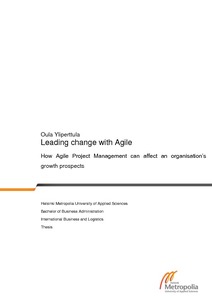Leading change with Agile : How Agile Project Management can affect an organisation’s growth prospects
Yliperttula, Oula (2017)
Yliperttula, Oula
Metropolia Ammattikorkeakoulu
2017

Creative Commons Attribution-NonCommercial-ShareAlike 1.0 Suomi
Julkaisun pysyvä osoite on
https://urn.fi/URN:NBN:fi:amk-2017053011258
https://urn.fi/URN:NBN:fi:amk-2017053011258
Tiivistelmä
The purpose of this thesis was to investigate if implementing agile methods can lead change in an organisation, if Agile Project Management can help the company grow and what are the consequences of applying agile methods to companies’ project management processes. As businesses seek for agility and strive for a more unique competitive advantage, being organisationally agile (able to adapt to changing market conditions and reacting to changing stakeholder requirements) is important. This paper analyses available secondary data about agile and its implications to form an understanding of agile methods and the effects it has on project management processes. The traditional project management processes and related elements are clearly introduced, after which a qualitative approach to secondary data gathering is applied. The approach suited the research well, as detailed information about agile was sufficiently available. Conducting primary data was not used because of its risk of widening the thesis scope and because more adapt research results were already available.
The key findings were that most companies seek enhancements to managing changing priorities and acceleration in time-to-market when they choose agile. The same aspects were reported as the largest “actually realised” improvements, in addition to increased productivity and improved product visibility. Some barriers for adopting agile further in an organisation still exist, however, and the largest reasons were reported to be the ability to change organisational culture, as well as general resistance towards change. Still, the use of agile methods is increasing, and experience from agile in organisations is reaching maturity, meaning more companies have stayed using agile for years.
The study concludes that agile can create a good environment for growth, but as projects vary, it may be difficult to apply agile methods into existing organisational culture. Strong change management is needed to implement agile well, but if agile is successfully adopted, the company can benefit from the added organisational agility.
The key findings were that most companies seek enhancements to managing changing priorities and acceleration in time-to-market when they choose agile. The same aspects were reported as the largest “actually realised” improvements, in addition to increased productivity and improved product visibility. Some barriers for adopting agile further in an organisation still exist, however, and the largest reasons were reported to be the ability to change organisational culture, as well as general resistance towards change. Still, the use of agile methods is increasing, and experience from agile in organisations is reaching maturity, meaning more companies have stayed using agile for years.
The study concludes that agile can create a good environment for growth, but as projects vary, it may be difficult to apply agile methods into existing organisational culture. Strong change management is needed to implement agile well, but if agile is successfully adopted, the company can benefit from the added organisational agility.
